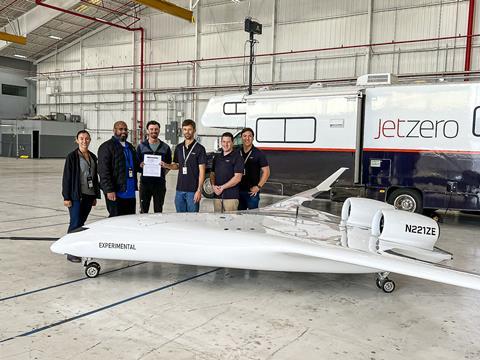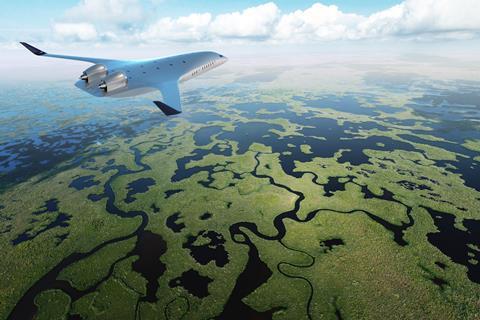A blended wing-body demonstrator aircraft developed by US start-up JetZero has received an airworthiness certification from the Federal Aviation Administration, advancing the company’s plans for a flight-testing programme in Southern California.
“This brings us one step closer to test flight of the Pathfinder 23ft scale model,” co-founder Tom O’Leary tells FlightGlobal on 26 March. “What it does is helps us test the flight controls and landing gear – really the critical enablers of this airplane.”
The FAA issued the experimental certificate for Long Beach-based JetZero’s Pathfinder, a 12.5%-scale demonstrator of a conceptual passenger aircraft that the start-up says will eventually provide 50% greater fuel efficiency than conventional tube and wing designs.
“It really addresses the number one challenge, which is efficiency,” O’Leary says. ”Lowering fuel burn by 50% would otherwise have been thought impossible, and, if demonstrated, will be then considered inevitable.”
JetZero has been test-flying a 2m (7ft) sub-scale model of its aircraft for months, but at 7m, Pathfinder is aerodynamically representative of JetZero’s full-scale design.

The company is developing a 250-passenger airliner with a blended wing-body “that can be flown with a level of aerodynamic efficiency that supports the dramatic fuel burn and carbon emissions reductions that the programme promises”, O’Leary says.
An upcoming flight-test programme with Pathfinder, to be conducted at yet-to-be-determined airfields and dry lake beds in Southern California, will seek to validate the aircraft’s flight characteristics.
The most intensive part of the programme will occur during the second quarter, though O’Leary expects that Pathfinder will be flown throughout the remainder of JetZero’s development process.
“Really, it’s all pointed in the direction of informing the full-scale demonstrator, the purpose of which is to prove the performance of this aircraft at full scale,” he says.
The start-up is working with the US Air Force to develop a full-scale prototype of its aircraft. The service is providing JetZero $235 million over the four years to fund the project, expecting to fly the full-size blended wing-body jet in 2027.

Blended wing-body designs share features of commercial jet aircraft and of ultra-efficient “flying wings”, such as the Northrop Grumman B-2 stealth bomber. NASA and Boeing flew an 8.5%-scale blended-wing-body demonstrator in 2007, known as the X-48B.
NASA notes that the design has several advantages, including low drag and high aerodynamic efficiency.
”Advantages of the blended wing-body concept include high fuel efficiency, low noise and a large payload volume for the size of the aircraft,” NASA says.
Whereas many other low-emissions aviation start-ups are seeking to cut carbon through advancements in propulsion technology, JetZero’s technology maturation is focused entirely on its airframe. In fact, its estimates of emissions reductions are calculated using the fuel burn of next-generation jet engines currently being used by commercial airlines, O’Leary says.
”I think we can show that this particular airframe will integrate very well into the highly optimised system of global aviation,” O’Leary says.
There are complexities associated with the design, however. “It’s fair to say that a non-cylindrical pressure vessel is the unique challenge of a blended wing body, which requires that we design a composite airframe,” O’Leary says. But he maintains that JetZero’s airframe will be easier to produce than that of, say, a Boeing 787, because of the design’s lack of “complex curvatures”.
“You essentially have a lot of flat surfaces, and that provides an advantage not just for safety and reliability, but for manufacturability,” he says.
The start-up plans to accelerate its path to certification by using largely available components. It is also planning to build several more Pathfinder prototypes for ongoing flight-testing purposes.
”We’ll have a flight-test test team that continues through the scale model on to a second scale model, the full scale model, the first conforming vehicle, the next several test vehicles for the certification programme, all the way up to delivering the first aircraft,” O’Leary says.
Pathfinder recently completed taxi testing at Long Beach airport.
































